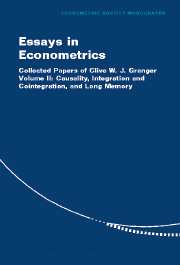Book contents
- Frontmatter
- Contents
- Acknowledgments
- List of Contributors
- Introduction
- PART ONE CAUSALITY
- PART TWO INTEGRATION AND COINTEGRATION
- 5 Spurious Regression in Econometrics
- 6 Some Properties of Time Series Data and Their Use in Econometric Model Specification
- 7 Time Series Analysis of Error Correction Models
- 8 Co-Integration and Error-Correction: Representation, Estimation, and Testing
- 9 Developments in the Study of Cointegrated Economic Variables
- 10 Seasonal Integration and Cointegration
- 11 A Cointegration Analysis of Treasury Bill Yields
- 12 Estimation of Common Long Memory Components in Cointegrated Systems
- 13 Separation in Cointegrated Systems and Persistent-Transitory Decompositions
- 14 Nonlinear Transformations of Integrated Time Series
- 15 Long Memory Series with Attractors
- 16 Further Developments in the Study of Cointegrated Variables
- PART THREE LONG MEMORY
- Index
11 - A Cointegration Analysis of Treasury Bill Yields
Published online by Cambridge University Press: 06 July 2010
- Frontmatter
- Contents
- Acknowledgments
- List of Contributors
- Introduction
- PART ONE CAUSALITY
- PART TWO INTEGRATION AND COINTEGRATION
- 5 Spurious Regression in Econometrics
- 6 Some Properties of Time Series Data and Their Use in Econometric Model Specification
- 7 Time Series Analysis of Error Correction Models
- 8 Co-Integration and Error-Correction: Representation, Estimation, and Testing
- 9 Developments in the Study of Cointegrated Economic Variables
- 10 Seasonal Integration and Cointegration
- 11 A Cointegration Analysis of Treasury Bill Yields
- 12 Estimation of Common Long Memory Components in Cointegrated Systems
- 13 Separation in Cointegrated Systems and Persistent-Transitory Decompositions
- 14 Nonlinear Transformations of Integrated Time Series
- 15 Long Memory Series with Attractors
- 16 Further Developments in the Study of Cointegrated Variables
- PART THREE LONG MEMORY
- Index
Summary
Abstract
This paper shows that yields to maturity of U.S. Treasury bills are cointegrated, and that during periods when the Federal Reserve specifically targeted short-term interest rates, the spreads between yields of different maturity define the cointegrating vectors. This cointegrating relationship implies that a single non-stationary common factor underlies the time series behavior of each yield to maturity and that risk premia are stationary. An error correction model which uses spreads as the error correction terms is unstable over the Federal Reserve's policy regime changes, but a model using post 1982 data is stable and is shown to be useful for forecasting changes in yields.
INTRODUCTION
A topic which is discussed frequently in the term structure literature is that of the relationships between yields associated with bonds of different maturities. Arbitrage arguments, often augmented by considerations about risk are generally used to justify such relationships; the underlying problem is to explain the empirical observation that yields of different maturity appear to move together over time.
Formal empirical analysis of the relationships between yields of different maturities is not straightforward because nominal yields are not generally considered to be stochastically stationary. It has long been recognised that it is possible for sets of nonstationary variables to move together over time. Granger (1981) formalised this concept, defining such sets of variables as cointegrated variables, and since then various tests for cointegration and techniques for working with cointegrated variables have been developed.
- Type
- Chapter
- Information
- Essays in EconometricsCollected Papers of Clive W. J. Granger, pp. 212 - 231Publisher: Cambridge University PressPrint publication year: 2001



